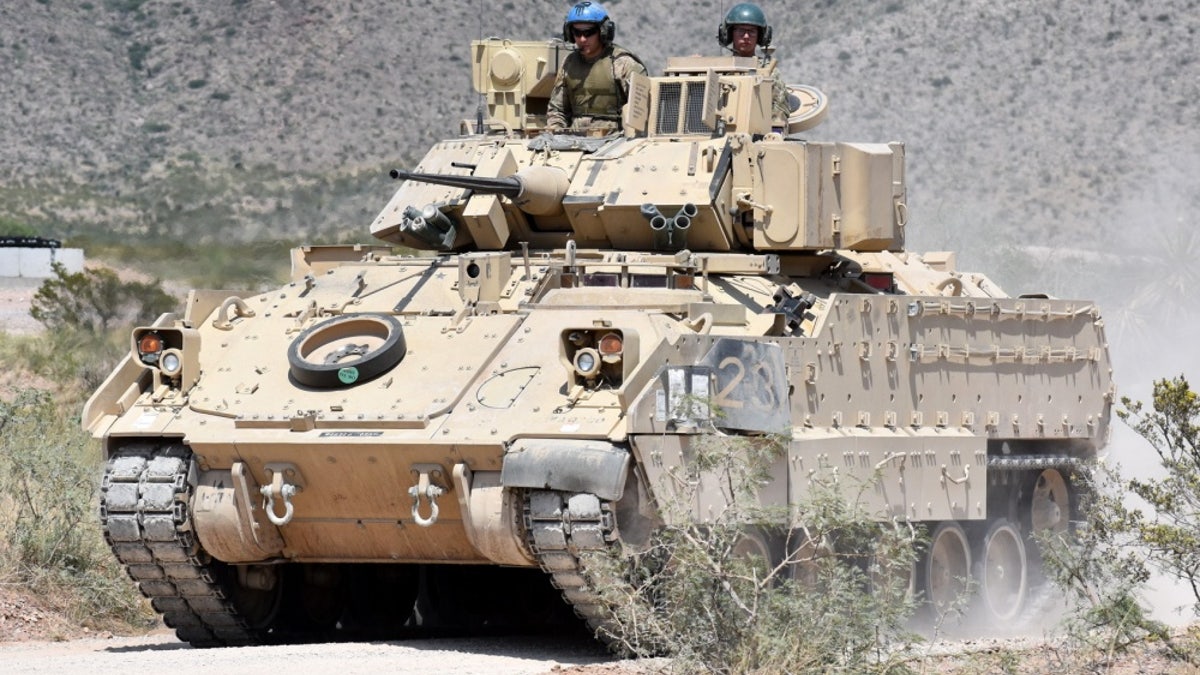
An M2A3 Bradley Fighting Vehicle crew heads to the range during gunnery training at the Doña Ana Range Complex, N.M., Aug. 3, 2018. (Winifred Brown, Fort Bliss Public Affairs Office)
The Army is arming Bradley Fighting Vehicles with heat-seeking Stinger air defense missiles to give the infantry carriers an improved ability to track and destroy enemy air threats such as drones, helicopters and low-flying aircraft.
Most current Bradleys are armed with TOW anti-tank missiles, a land weapon predominantly used for attacking enemy armored vehicles, bunkers or troop formations. Adding Stinger missiles will increase the attack envelope for the vehicles and potentially better enable them to protect maneuvering infantry and mechanized forces in combat.
“As directed by the Chief of Staff of the Army, the Army is conducting a proof of principle to incorporate Man Portable Air Defense Systems back into the Armored Brigade Combat Teams by modifying two dozen Bradleys to carry Stinger Missiles in lieu of TOW Missiles,” Ashley Givens, spokeswoman for Program Executive Officer, Ground Combat Systems, told Warrior Maven.
As anti-armor weapons, TOW missiles are not typically used to attack enemy air threats.
“Current versions are capable of penetrating more than 30 inches of armor, or "any 1990s tank," at a maximum range of more than 3,000 meters. It can be fired by infantrymen using a tripod, as well from vehicles and helicopters, and can launch 3 missiles in 90 seconds,” the Federation of American Scientists writes in a paper.
Stinger missiles, by contrast, are infrared-guided surface-to-air weapons with nearly twice the range as TOW missiles.
Adding Stingers to Bradleys is entirely consistent with the Army’s broad strategic aims for the Bradley, which call for a highly-networked infantry carrier increasingly able to maneuver in support of ground infantry using long-range, high-tech sensors to find and hit targets.
“The Army has chosen to increase the cross-country mobility of the Bradley, allowing it to go further into off-road situations to support infantry formations,” Givens said.
An extended range TOW 2B Aero, engineered with a one-way radio link and range enhancing nose-cap, can hit targets more than four kilometers away; a Stinger missile, however, can reportedly hit targets out to eight kilometers.
Army information says a TOW Bunker Buster warhead consists of a blast type warhead designed to penetrate and then detonate inside Military Operations in Urban Terrain targets such as 8-inch double reinforced concrete, brick-over-block, and triple brick walls. The warhead utilizes both a cast titanium body and chisel style nose to allow better penetration capability while reducing ricochet probability.
The latest TOW upgrade uses Target Acquisition Systems that incorporate Far Target Location capability (ITAS-FTL), a technology which incorporates a global positioning satellite-based position attitude determination subsystem, Army officials said.
An Army paper says ITAS is the fire control system for the TOW missile and consists of integrated optical and second-generation forward-looking infrared sights and an eye-safe laser range finder. It offers improved hit probability by aided target tracking, improved missile flight software algorithms, and an elevation brake to minimize launch transients
“The TOW ITAS system provides the Soldier an instant grid location of his position and of the target that he sees in his ITAS sight. It is accurate to a 60-meter CEP (circular error of probability),” an Army report said.
Although described by Givens as a “limited effort,” integrating Stinger onto Bradley is a part of the broader Army Short Range Air Defense Strategy, an effort to strengthen air defense weapons across infantry brigade combat teams.
“This is a limited effort designed to inform the Army on Short Range Air Defense employment techniques and considerations,” she said.
The Army SHORAD program, already being built into Stryker vehicles, represents a service-wide strategic and tactical need to respond to near-peer type mechanized combat threats. Focused on heavily during the Cold War, when facing a Soviet threat, SHORAD faded a bit during the last 15 years of ongoing ground wars. The Taliban and Iraqi insurgents did not possess much of an air threat.
However, today’s global threat environment is vastly different. Potential adversaries can easily acquire drone attack technology, as it is readily available on the international market. This means enemies could hold Army units at risk from the air in newer, more dangerous ways – and at farther ranges. Furthermore, the advent and proliferation of weaponized drones, enabled by growing levels of autonomy, could use long-range EO/IR to target and attack advancing infantry and armored units in ways previously not possible.
Chinese or Russian helicopters and drones, for instance, are armed with rockets, missiles and small arms fire. A concept with SHORAD would be to engage and hit these kinds of threats prior to or alongside any enemy attack. SHORAD brings an armored, mobile air defense in real-time, in a way that most larger, less-mobile ground missiles can. PATRIOT missile, for instance, is better suited to hit incoming mid-range ballistic missiles and other attacking threats. While mobile, a PATRIOT might have less of an ability to support infantry by attacking fast-moving enemy helicopters and drones.
Also, it goes without saying that any kind of major enemy ground assault is likely to include long range fires, massive air support as well as closer in helicopters and drones to support an advancing mechanized attack.
As a result, ground infantry supported by armored vehicles, will need mobile air defenses to address these closer-in air threats. This is where the Stryker or Bradley SHORAD comes in; infantry does not have the same fires or ground mobility as an armored Stryker or Bradley, and hand held anti-aircraft weapons such as a hand-fired Stinger would not have the same defensive impact as a Hellfire or Stinger armed armored vehicle. In a large mechanized engagement, advancing infantry needs fortified armored support able to cross bridges and maneuver alongside foot soldiers.
More Weapons and Technology - WARRIOR MAVEN (CLICK HERE)--




















